The Square Collection – Diagonal Bobble Stitch.
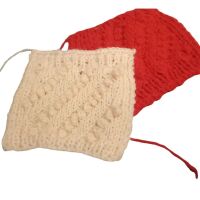
This is part of our monthly Blanket Club. Patterns are released every month on the website – then published in a booklet after a year.
The squares worked in DK measure about 4 ½” square – and the larger ones 8” square. You could use 3 strands of DK together – working on 8mm knitting needles – and the square will be bigger.
You will need;
1 strand of double knitting to be worked on 4mm knitting needles – about 12g
Or 2 strands of double knitting (equal to chunky weight yarn) to be worked on 6mm knitting needles – about 20g
If you are using the double knitting weight of yarn, then use 2 strands together throughout.
- If you are using the chunky weight of yarn, then use 1 strand throughout.
- Remember to count all the rows as you work up the square.
The technique you need to make the bobble is as follows – [knit 1, purl 1, knit 1, purl 1, knit 1, purl 1] all into one stitch. Then slip the second stitch in over the last stitch – slip the next in line over the last stitch – then the next in line over, and again until you are back to just the 1 stitch. Do this every place the pattern says ‘make bobble’.
TIP – if you get lose your place ( it’s easy to gain a stitch if you don’t take enough of the bobble loops back over) – remember to create each bobble AFTER the column that the previous one is in – making it go in a diagonal slant.
Cast on 28 stitches.
Row 1: *(knit 1, purl 1) – repeat from * to end.
Work row 1: 3 more times more.
Row 5: knit 1, purl 1, knit 1, purl 1, knit 1 *knit 2, make bobble, purl 3 – repeat from * to last 5 stitches, purl 1, knit 1, purl 1, knit 1, purl 1.
Row 6: knit 1, purl 1, knit 1, purl 1, then work each stitch the way it lies – purl into a purl – knit into a knit, (the bobble is a knit stitch) to last 4 stitches, knit 1, purl 1, knit 1, purl 1.
Row 7: knit 1, purl 1, knit 1, purl 1, knit 1, purl 1, *knit 2, make bobble, purl 3– repeat from * to last 4 stitches, knit 1, purl 1, knit 1, purl 1.
Row 8: knit 1, purl 1, knit 1, purl 1, work each stitch the way it lies – purl into a purl – knit into a knit, to last 4 stitches, knit 1, purl 1, knit 1, purl 1.
Row 9: knit 1, purl 1, knit 1, purl 1, knit 1, purl 2, *knit 2, make bobble, purl 3, repeat from * to last 9, knit 2, make bobble, purl 2, knit 1, purl 1, knit 1, purl 1.
Row 10: knit 1, purl 1, knit 1, purl 1, work each stitch the way it lies – purl into a purl – knit into a knit, to last 4 stitches, knit 1, purl 1, knit 1, purl 1.
Row 11: knit 1, purl 1, knit 1, purl 1, knit 1, purl 3, *knit 2, make bobble, purl 3, repeat from * to last 8 stitches, knit 2, make bobble, purl 1, knit 1, purl 1, knit 1, purl 1.
Row 12: knit 1, purl 1, knit 1, purl 1, work each stitch the way it lies – purl into a purl – knit into a knit, to last 4 stitches, knit 1, purl 1, knit 1, purl 1.
Row 13: knit 1, purl 1, knit 1, purl 1, knit 1, make bobble, purl 3, *knit 2, make bobble, purl 3, repeat from * to last 7, knit 2, make bobble, knit 1, purl 1, knit 1, purl 1.
Row 14: knit 1, purl 1, knit 1, purl 1, work each stitch the way it lies – purl into a purl – knit into a knit, to last 4 stitches, knit 1, purl 1, knit 1, purl 1.
Row 15: knit 1, purl 1, knit 1, purl 1, knit 2, make bobble, purl 3, *knit 2, make bobble, purl 3, repeat from * to last 6, knit 1, purl 1 knit 1, purl 1, knit 1, purl 1.
Row 16: knit 1, purl 1, knit 1, purl 1, work each stitch the way it lies – purl into a purl – knit into a knit, to last 4 stitches, knit 1, purl 1, knit 1, purl 1.
This is the pattern layout. Repeat rows 5 – 16 once more.
Row 29: *(knit 1, purl 1) – repeat from * end.
Repeat last row 3 times more.
Cast off.
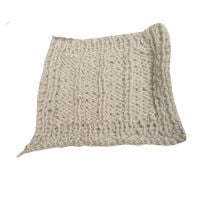 Cast on 29 stitches.
Cast on 29 stitches.
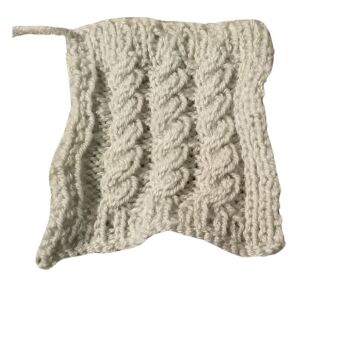
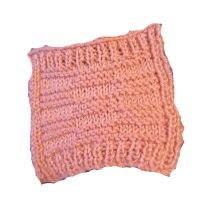 Garter Stitch Blocks
Garter Stitch Blocks
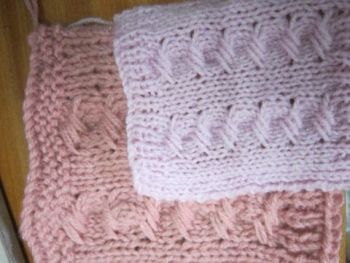 Long Cross Stitch Square
Long Cross Stitch Square You will need;
You will need;